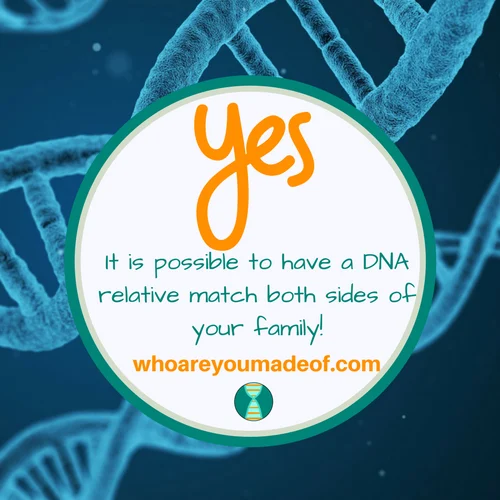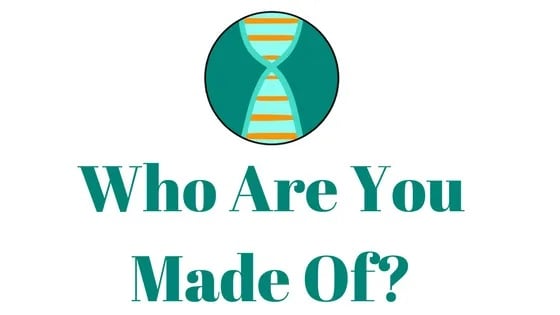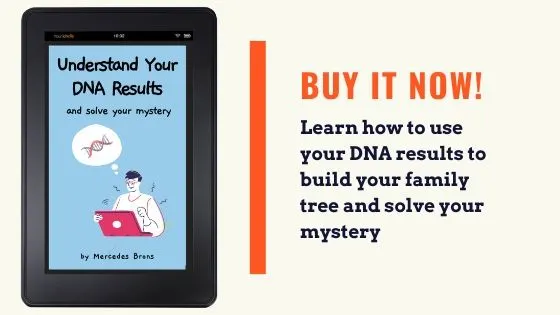Is common to have a DNA match who matches both sides of your family tree? In this post, learn whether this is possible and how it happens.
Most people discover that a match is on both sides of their family through a matches in common or shared matches utility offered by their DNA testing company. If you have found a DNA match that seems to match you on both sides of your family and are wondering how this could be possible, you have come to the right place.

This happens more often than you might think, believe it or not. By the time you are done reading this article, you'll understand more about the topic.
If you find that your DNA match is related to you on both sides of your family, this means that you are related in two different ways!
You could be a 5th cousin twice-removed on one side of the family, and a 4th cousin once-removed on the other side of your family. That's pretty neat!
Be aware of the fallacy of shared matches
Before we begin, you should know that a shared match with some from whom you are not descended does not necessarily mean that all three of you are related in the same way. It is possible for you, your DNA match, and your shared matches, to be related in different ways.
As an example: I am examining Robert, a DNA match, and I see that Robert and I share in common my first cousin, Sarah, who is related on my dad's side of the family, but we also share my mother in common.
Does this mean that my dad, who in this example has not done a DNA test, is related to Robert, too?
It's possible, but since I am not descended from Sarah, and since 50% of Sarah's ancestors are not related to me, there is always the possibility that Sarah and Robert and related to each other on one line of Sarah's family, and Robert and I are related to each other on a different line.
In other words, we all share each other in common as DNA matches, but we do not all share the same common ancestor.
The more distant the cousin, or relative, the higher the chance that a shared match is related on a completely different line of the family. 50% of a first cousin's ancestors are also your ancestors, so there is actually a good chance that a common match is actually related to both of you in the same way.
A second cousin will share 25% of their ancestors with you (a half-second cousin only 12.5%) and a third cousin will only share 12.5% of their ancestors with you (a half-third cousin only 6.25%).
I mention all of this because you should always be away and have an open mind when you are looking at your DNA matches. It's best to know ahead of time what you might encounter, and family trees and DNA can get tricky.
If your DNA match also matches both of your parents:
It's possible to have a DNA match who matches both of your parents - it's not your imagination. If you have a DNA match who matches both of your parents, it is possible that you inherited a DNA segment from each parent which also matches your match.
Alternatively, it is possible that you inherited a DNA segment from only one of your parents which matches your DNA match. Below, I'll talk a little bit more about these scenarios.
But first, I will answer a common question that usually comes up during this type of discussion.
If you have a match who matches both of your parents, does this mean that your parents are related?
Unless you have a reason to think that your parents are related, they are probably not closely related. However, there are studies showing that we go far enough back in our trees, we would eventually find common ancestors with our spouses.
This would be especially true if our parents share a common ethnic heritage.
In this magical scenario where we all are able to definitively know all of our ancestors 12 generations back on all lines of our families (yeah, right!), it should be noted that we would no longer have detectable DNA segments from those very distant ancestors.
This is because we didn't inherit DNA from all of our ancestors.
Additionally, we would probably not share DNA segments in common with our spouse or anyone else descended from those 12th great-grandparents.
Both of my parents have pretty recent German ancestry, and German is the only recent ancestry that they share in common. I've run the One-to-One comparison tool on Gedmatch, and they share absolutely no DNA segments, not even as small as 1 cM, as many unrelated human beings might.
It's interesting to note that my mother and my father's uncle share five separate DNA segments ranging from 3-5 cMs, and while these are probably coincidentally identical segments, it is interesting that I continually find DNA matches that they share in common.
I have still yet to find no real evidence that my parents are related to each other in any way.
My husband's parents, however, were most definitely related to each other. He comes from a small town in another country, and most people who live there say that their families have been living in the same town for many generations.
Gedmatch estimates that his parents were related to each other at only about 4.2 generations. Since I know that the community where they live is endogamous (meaning that people have been marrying within the relatively isolated community for many generations), it's likely that his parents are slightly more distant than that.
The takeaway is that if your parents have ancestry from a similar region, especially from the same state or town, the likelihood increases that they may be related to each other, albeit possibly very distantly.
If your parents have no known common ancestry, then it is more likely that the DNA match that you share in common with both of them is related to you through completely different lines of your family.
When you have inherited DNA from both of your parents that matches a particular person
In this scenario, you have inherited a DNA segment from each of your parents that is identical to that of your DNA match. Depending on which testing company you use, there are a few ways that you can determine that this is the case, even if you don't have access to your parents DNA results:
- You share more DNA with the match than your mother or father do, even those they both show up as a shared match with your relative
- You share more than one DNA segment with a relatively distant cousin, who also matches both of your parents
A few other things to keep in mind:
- Don't forget to use some of the basic genetic genealogy strategies to figure out the two different ways you might be related, such as looking for other shared matches on each side of your family to see if you can narrow down the lines where you should search for common ancestors.
- Check to see if your DNA match has a family tree posted, since you might be able to spot common surnames - or even all of your common ancestors, if they have a pretty complete tree.
If you didn't inherit any DNA from one of your parents that matches your match, but the match matches both of your parents
It is possible that both of your parents can be related to a match even if you only inherited DNA from one of your parents that matches your match.
Remember that we don't inherit all of our parents' DNA, which means that even if you share both of your parents in common with a DNA match, you might have only inherited a segment from your dad that matches the match.
Your mom, since she definitely shares the match in common with you, is likely still related to this match since she shares an identical segment, but she didn't pass that segment down to you.
You can find out if this is the case by uploading your DNA to Gedmatch, and nicely requesting that all parties involved do the same.
Many people don't know about Gedmatch, so you can just let them know about this really cool website where they can find DNA matches from other companies and get access to free tools for learning more about their DNA and ancestry.
If all of the DNA kits are already on Ancestry, run the One-to-One tool comparing each combination individually. The idea is to see where you match on each chromosome to find out if you inherited DNA from both of your parents that match your shared match.
If your DNA match also matches another relative, but not your parent
This scenario is a perfect example of how it is so important to test our older relatives, and how DNA is inherited. Since we only inherit 50% of our DNA from each parent, some DNA is "lost" each generation.
I have matches that I share in common with my mother and my father's mother (my grandmother). I don't think there is any relation whatsoever between my mother and my grandmother, so it just means that I am related to these matches in a few different ways, both on my mother's lines and my grandmother's lines.
The crazy thing is that my father didn't get the identical segments from his mother, and so he couldn't pass them down to me. He simply inherited DNA from his mother that didn't include segments that would match these people who are also related to my mother.
My mother has one line of her family that can be traced back to colonial times, and most of my grandmother's ancestry is from this period, and that is why I believe that this occurs in my DNA matches.
Do you need more DNA matches in order to figure out something that has been puzzling you?
If you are interested in finding more DNA matches without having to take a DNA test with a different company, you might be surprised to know that there are several websites where you can upload your DNA for free (or a nominal charge) in order to find more DNA matches and have access to different tools for analyzing your DNA.
I've written two posts on this topic, as a matter of fact.
One post is about using Ancestry DNA on other sites, but it can be helpful for anyone, and the other generally about free places to upload your DNA and the different things you can learn.
Conclusion
I hope that this post helped you understand a little bit about how it can be that you match a DNA match on both lines of your family, whether or not you inherited a DNA segment from both of your parents matching your match.
I've probably hit a world record for the use of "match" in a blog post. If you have any questions, comments, or would like to share your own experience with this type of issue, I would love to hear from you in the comments.
Thanks for stopping by!


Js.
Tuesday 31st of December 2024
I don't think I'm reading the same message than everyone here in the comment section because ever match I've gotten were all West African and African African and I'm not black that I know of?
Joy
Sunday 29th of December 2024
I found a DNA match that was for both sides of my family, and a common match for both of us was one of my sons. At first I thought perhaps it was his child, but when my other son did his DNA, it turns out that match was his son, who, of course, shared lineage with both me and my sons. So it may be a match is downstream and not upstream.
Deb
Tuesday 12th of November 2024
Google Search says "no" I can't have "throwback" DNA (a little different from what you're talking about), but I do. Got confused searching my DNA. It goes back to same households centuries ago to where I get confused (not all of it) My dad has a lot of German. I only have 3%. I gave my daughter 25% German. My DNA goes back to the pilgrims over and over. The Aldens, from different children. Priscilla was mother in most but step mother in some. (And other pilgrims) Goes back to same households in England. ("Oh God, tell me he's not my relative twice" - the martyr guy with too many wives - he ended up step father). My dad's father however is a mystery. He was raised by a man by the last name of "Paul" is all I know. Came here during the wars at the time of Prince Philip (Elizabeth II's husband). But from all this DNA, I'm 63% UK/NW European moderately from the Channel Islands and 25% Scottish very strongly from the Isle of Man. I think that's strange. So I was wondering if it even vaguely possible I could match DNA enough to show I am a relative to someone say from The Isle of Man in the 14 or 1500's? My DNA is crazy compared to the rest of my family. Plus "Ancestry" took away 10% of Norway? and all of Denmark Sweden and replaced it with Iceland ... (I can see adding and reducing UK/NWE but not taking away?) Can you email me an answer to question about is it possible to have extreme "throwback" DNA? My niece shares as much DNA with me as my grandchildren, so I am not adopted .. I do have different features from the rest of family also.
Judy
Wednesday 1st of November 2023
After reading your article I am no clearer. I have a cousin with whom I share 20% DNA: 1,403 cM across 34 segments. This "cousin" is in fact not my1st cousin. She is the daughter of my mothers ½ brother. Ancestry also say she is related to me on both sides. After my DNA results I discovered my dad is not in fact my father. I have no matches whatsoever with any of my family on dads side. Both of my parents have passed so I can't test them. Can you please throw some light on this? Tahnk you.
Brian Drummond
Sunday 10th of September 2023
My great grandmother was married twice, my grandfather was born to her second marriage yet I am getting DNA matches with her first husbands family with whom I am not a descendant, is that possible ?